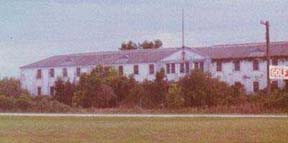CHAPTER 8
JANUARY 25, 1944 -- MAY 1, 1944
NAS GREEN COVE SPRINGS, FL.--OPERATIONAL FLIGHT TRAINING |
Bloski and I received orders to report to Green Cove Springs
Naval Air Station near Saint Augustine, Florida. We received
6 days travel time to go about two hundred miles. What to do
with 6 days? We decided to go to New Orleans. Even though it
was in the wrong direction it wasn't far and we had neither been
there before. Good idea! Besides, it would give me a chance to
find out what had happened to B.J. Moise.
We bought bus tickets, boarded the bus, walked to the seat that
crossed the back of the bus and flopped. Lots of room and besides
there were only about five people on the whole
|
bus. The bus didn't move. The driver just sat there in
his seat and kept looking in the rear view mirror at us. Finally
he got up came back and said: " You boys will have to move
forward. This section is reserved for the "Colored".
OK! We moved forward. This was my first, last and only experience
with " Jim Crow". We arrived safely in New Orleans
with no further incidents. |

A former NAS Green Cove Springs building photographed in 1976 |
I knew that B.J.'s parents lived in the Roosevelt Hotel and that
his father was president and general manager of Maison-Blanche
Department Store in New Orleans. So this was the place to start.
We entered the store and asked a clerk where we might find Mr.
Moise. She directed us to the offices on the second floor. At
the end of the hall was an office door that bore the name: Benjamin
J. Moise, President/General Manager. We entered to find in the
first office, Mr. Moise's secretary. We introduced our selves.
She picked up the phone and in an instant we were sitting in
this gigantic office talking to B.J.'s father. After a few minutes
he called his secretary and asked her to find his wife-she was
in the store. In a couple of minutes she was in the office treating
us like long lost kin. I would have to say they couldn't have
been more accommodating. Mrs. Moise invited us and insisted upon
showing us the town. She called for her car and upon leaving
the store we were to enter a big long black limousine which she
drove. After picking up B.J.'s sister we were treated to lunch
at Antoine's then shown every point of interest in New Orleans
from the "French Quarter, Bourbon Street, the cemeteries
where everyone is buried in vaults above ground because it is
not possible to keep the bodies under ground because of the water
level, and also a trip to Lake Pontchartrain. The answer to my
quest of B.J.'s fate was that he had left the Navy and had been
drafted as a buck private in the Army. We were invited to dinner
but had begged off because of another commitment. Wasn't true
but they didn't know. We were more interested in Bourbon Street.
After two days in New Orleans we were off to Green Cove Springs.
As student officers, Bloski and I, being numbers one and three
on the alphabetical list, were assigned as roommates again. Don't
know why I didn't draw Bates. There were seven students in our
flight, five of whom I hadn't met before. They were Harry Bates,
Walt Glista, Sy Gonzalez, Mike Michelich and Bill Tuohimaa. Bloski
was also in the Flight. The instructor we were assigned to was
Lieutenant Quentin Crommelin. . He was a full Lieutenant, a graduate
of the Naval Academy and had been on sea duty as a gunnery officer
prior to entering flight school. No experience in combat as a
pilot and he was teaching us how to kill and not be killed.

Walt Glista, Mike Michaelich, Robert Allison
William Touhimaa, Harry Bates, Sy Gonzalez, Tom Bolski |
There is an interesting story about Lt. Crommelin. Not
only was he a graduate of the Naval Academy but he was the youngest
of five brothers who were all graduates of the Naval Academy.
The eldest, Captain John Crommelin was an Aviator and was on
the USS Liscome Bay, CVE 56, when it was sunk by a Japanese U-boat
in the South Pacific Ocean. He survived. Second was Commander
Charles Crommelin, who died in combat as a fighter pilot. |
Third, a Lieutenant commander, whose name I don't remember, was
the captain of a destroyer. Fourth, Lieutenant Commander Richard
Crommelin, also an aviator who flew back to his carrier in a
damaged plane with his body racked with shrapnel and one of his
eyes hanging on the outside of his cheek. He landed but couldn't
control the plane. It crashed into the bridge of the carrier.
He survived only to become a fatality in a mid-air collision
with another Navy plane during the Okinawa campaign. The fifth
and youngest was our instructor.
The Crommelins were true Southerners from Alabama. One day, our
instructor arranged for us to go to the skeet range where we
were to learn to lead a moving target when shooting at it. Everything
was going along fine until a mockingbird made the mistake of
landing on a fence on the side of the skeet range. Bates couldn't
resist the temptation. He blasted that bird into guts and feathers.
The Lieutenant blew his stacks and we were off to the B.O.Q.
Someone came up with the idea that the mockingbird is the Alabama
state bird. Well, maybe so, but I believe his attitude had a
little something to do with safety.
|
|